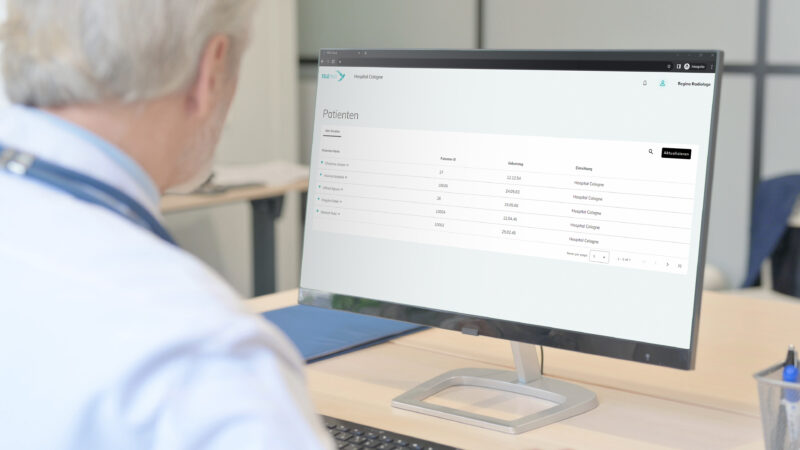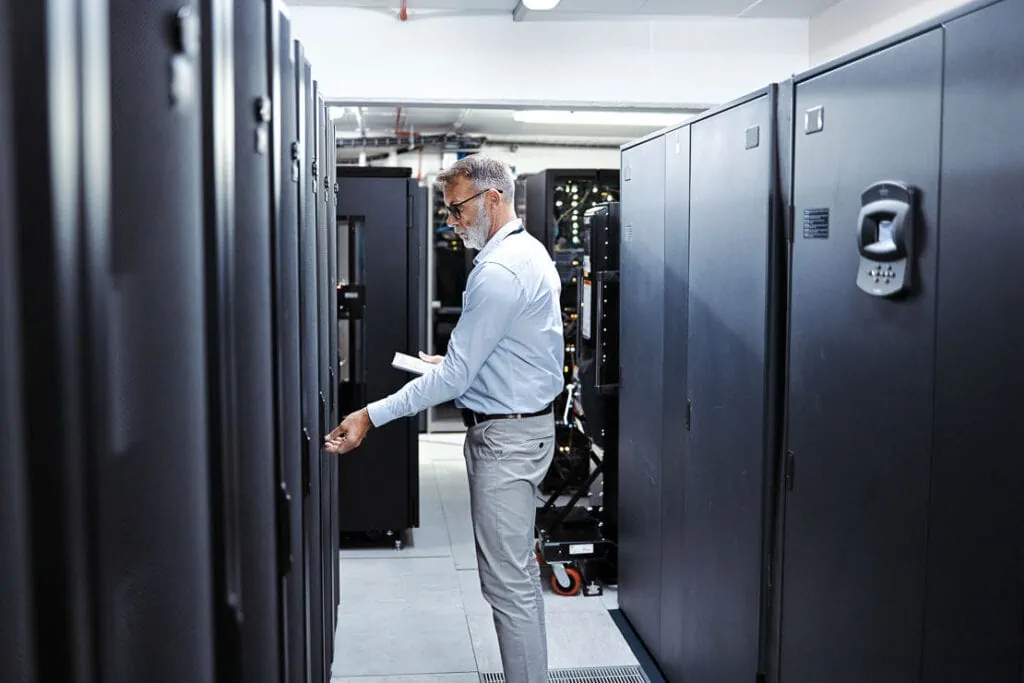- By Miriam Friedmann
Modern teleradiology: efficient image exchange in the cloud
Flexible, secure and available at all times: Cloud technologies are revolutionising teleradiology and therefore the everyday lives of many radiologists. Digital technology enables the virtually limitless exchange of radiological images within a networked system. We show how teleradiology can make everyday medical work in clinics much easier.

Teleradiology: One term, two interpretations
1. Teleradiology according to the Radiation Protection Act
Let us first clarify the double meaning of the term teleradiology: On the one hand, there is teleradiology according to the Radiation Protection Act (StrlSchG) with all its regulations.
It describes the possibility of creating radiological images without the presence of a radiologist. Although the radiologist is connected to the hospital staff by telecommunication during the examination of the patient, he or she monitors and is responsible for the examination from a different location.
This is particularly relevant for smaller clinics in rural areas, for example, which simply cannot afford to employ a radiologist around the clock.
2. Teleradiology for consultation purposes
Secondly, the term teleradiology refers to the exchange of radiological images within a network such as a hospital or practice network.
The focus is on the interpretation of radiological images or obtaining second opinions from colleagues for consultation purposes - but not on the creation process itself, as is the case with teleradiology in accordance with the Radiation Protection Act.
Efficient radiological findings thanks to cloud-supplied teleradiology
Cloud technology is becoming increasingly important, particularly for teleradiology as a consultation option or for obtaining second opinions. After all, radiological images and findings are an essential basis for both inpatient and outpatient diagnostics and treatment. Being able to call up, view and assess this information at any time and from any location is essential for modern radiological everyday life.

Advantages of cloud teleradiology in everyday medical practice
Advantage 1: Access independent of time and place
Gone are the days when images were stored locally on a hospital server and accessing them either required special, previously installed software at a defined workstation or involved considerable effort to send the images to the radiologist in compliance with data protection regulations. Thanks to the cloud and the secure online access it enables, teleradiology has become independent of time and location.
Benefit 2: Faster start of patient treatment
This type of teleradiology also plays an important role when patients are transferred to another hospital, for example to one with a neurosurgery department for an emergency patient with a brain aneurysm. Ideally, the images reach the doctor providing further treatment before the patient. Treatment can then begin as soon as the patient arrives.
Advantage 3: Technical safety
Cloud solutions offer a more secure, technological option for exchanging image data compared to conventional messenger services or email. From the cloud, the doctor shares the radiological images directly with colleagues for diagnosis.
How the cloud solution solves current challenges in everyday clinical practice
In the acute area of conflict between the digitalisation and modernisation of the entire German healthcare sector, increasing financial burdens and a lack of specialists, cloud teleradiology can make a significant contribution to relieving the burden on clinics and radiology departments.
Absorbing short-term staff shortages
Thanks to remote diagnosis by other hospital locations or by doctors from cooperating radiology practices, short-term staff shortages can be compensated for, for example, in the event of sickness absence from other locations. This means that patients can also be treated across all facilities.
Optimize personnel resources
With the cloud solution, medical facilities can also bridge planned periods with low staffing levels due to holidays or night shifts. With the Telepaxx Medical Data Cloud (TMD Cloud) , recurring access authorisations can be defined for reporting at different locations, for example.
For example, all images generated in a hospital's emergency department between 10 p.m. and 6 a.m. should always be analysed by a radiologist at another hospital site and automatically transmitted there
Enabling more flexible working time models
Enabling more flexible working time models Cloud-based remote diagnostics also makes it easier to implement more flexible working time models: Radiologists can view and analyse images safely from their home office. This helps to better reconcile family and career and helps to increase employer attractiveness.

Differentiation between cloud-based teleradiology and teleradiology in accordance with the Radiation Protection Act
As mentioned at the beginning, there are different interpretations of the term teleradiology. The definition according to the Radiation Protection Act was last amended in December 2018. This is because on 31 December 2018, the Radiation Protection Act (StrlSchG) replaced the X-ray Ordinance (RöV). Even though the law introduced a few changes, for example with regard to the specialist knowledge required of teleradiologists, one requirement remained unchanged: The mandatory authorisation from the responsible radiation protection authority.
The provisions of Section 14 (2) StrlSchG in conjunction with Section 123 StrlSchV are also authoritative. In addition, the legislator defines the following framework conditions.
Teleradiology: General conditions according to StrlSchG
Teleradiological diagnostics should remain the exception. The justifying indication to be provided by a radiologist or another doctor with specialist knowledge in radiation protection must be based on a personal examination of the patient on site (Section 83 (3) sentence 4 StrlSchG). Therefore, the regular operation of X-ray machines and computer tomographs for teleradiology can only be authorised at night, at weekends and on public holidays.
Exceptions to the authorisation for daytime work during the week are, for example, smaller specialist or affiliated hospitals. These often have so few radiological examinations per day that it is not economically viable to employ a radiologist on site.
This is to ensure that the radiologist can influence the examination via telecommunications and the doctor and MTR present on site.
According to §§ 123 Para. 3, 145 Para. 2 No. 2 and 3 of the Radiation Protection Ordinance (StrlSchV), medical technologists for radiology (MTR) have the necessary expertise in radiation protection and are therefore authorised to carry out technical examinations.
According to the RöV, the teleradiologist had to be a doctor who had the necessary expertise in radiation protection for the entire field of X-ray examinations. As such doctors are in very short supply, Section 5 (38) StrlSchG now also allows doctors who only have the specialist knowledge for a single area of application (e.g. CT) to be employed as teleradiologists in this area.
The necessary requirements for the doctor on site of the examination are set out in Section 6.2.2 of the Medical Specialist Guideline.
Conclusion: Integration of new technological solutions harbours considerable potential for findings
In summary, it can be said that teleradiology has a legal framework due to clear regulations and guidelines in accordance with the Radiation Protection Ordinance.
In addition, the integration of cloud solutions opens up considerable opportunities to carry out findings regardless of location. The advantages are obvious: the relief of individual doctors and locations on the one hand and the return of specialists who were previously no longer working due to attendance obligations on the other.

Initial Consultation
You have questions?
Feel free to contact me to learn more about how you can share and diagnose medical images cloud-based across locations in your medical facility.
Other articles that may interest you.

DigitalRadar: How digital are German hospitals?
The first interim report of the DigitalRadar paints a sobering picture of the digitization of German hospitals. The KHZG-funded projects aim to change this. Find out more here.

The German health data use act in check
The German Health Data Use Act - GDNG in short - is set to revolutionize health research in Germany. Read about the most important goals, questions and answers.

Bavarian Hospital Act: patient data permitted in the cloud
Bavarian hospitals have been allowed to process patient data in the cloud since June 2022. You can read about the advantages of this and what to look out for here.